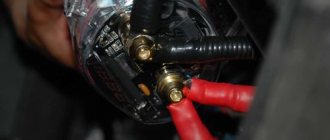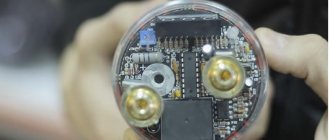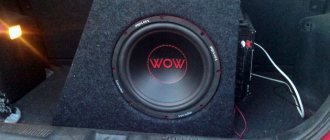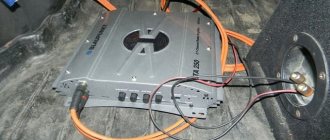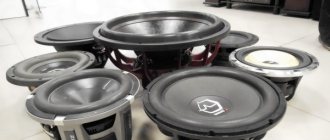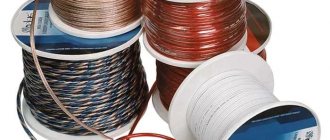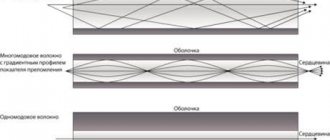A car subwoofer capacitor is becoming increasingly popular among car owners. Now the installation can be found not only in expensive audio systems, but also in simple sets of audio equipment that use external sound amplifiers.
Do you need a capacitor for a subwoofer? Drivers who understand the meaning and functionality of the device answer unequivocally: of course it is needed. Since this device significantly improves the performance of the amplifier, as well as the quality of the sounds produced.
Operating principle of a capacitor
For modern subwoofers, short-term peaks are enough to start drawing more current. As a result, it cannot fully provide energy to the battery. Even the thick wires that feed the amplifier do not have such resistance that will cause a decrease in voltage at the moments of the pulses.
Connecting a subwoofer to an amplifier and capacitor
As a result, the functionality of the amplifier is reduced. To eliminate such phenomena, it is necessary to install a drive in the car. It is an electrolytic device with a large capacity. Connected in parallel with respect to the power circuits on the amplifiers. The resistance of the equipment is very low, and the current is transferred to the amplifier at lightning speed. Thanks to this, the occurrence of subwoofer malfunctions is excluded. Just as quickly, the capacitor is recharged again and “gives” a portion of the current back.
So, what is a subwoofer capacitor for? In simple words, we can say this: the device accumulates and quickly transmits electricity. In technology, this function is used to improve the sound of a car radio.
Capacitor
There is an opinion that the current storage prolongs the life of the battery or facilitates its operation. And some car owners install devices based on this consideration. But this is a proven myth! The storage device does not produce energy. It only accumulates electricity and delivers it to the consumer.
Marking
Marking of modern drives is carried out in the following ways:
- Three digits - with this marking, the first two digits are the mantissa, and the third is the power of the base 10;
- Four digits - in this marking the mantissa is the first three digits, the fourth is the power of the base 10;
- Alphanumeric - in this designation, the numbers indicate the capacitance value, and the letter - the decimal point (p or p - picofarads; n - nanofarads; µ or m - microfarads).
In drives that have a large case, the operating voltage and capacity are indicated on it in the form of two numbers. So, for example, if the case is marked “1 µF 50V”, this means that the drive has a capacity of 1 microfarad and an operating voltage of 50 volts.
What types of automotive capacitors are there?
Today, many different capacitors for cars are already produced. From the simplest and cheapest models, to elite and expensive ones, with a large capacity of 20F. Such capacious installations are used in powerful equipment that has a distributor and has the ability to connect more than two amplifiers at the same time.
Automotive capacitor
The choice of device depends on several factors. Basically, you need to consider the power of the car's battery. Never buy equipment if it looks questionable. Capacitors have the “property” of exploding. And even the slightest violation of the integrity of the structure can lead to an explosion.
When inspecting the device in a store, you need to pay attention to the presence of protection on the terminals. They protect the system from accidental short circuits. It is also important to study the ease of connection and installation.
Automotive capacitor
Story
The prototype of the modern capacitor was constructed in 1745 simultaneously by two scientists: the Dutch physicist Pieter van Musschenbroek and the German Lutheran cleric Ewald Jürgen von Kleist. The first called his invention the “Leyden jar”, the second – a medical jar. The similarity in the names was not accidental - the device, both German and Dutch, was a glass jar with two tin plates located on its outer and inner surfaces, with a dielectric plug inserted into the neck, which was pierced by a metal rod with a chain. Such a device was charged from an electrophore machine, which was very popular in those days. The charge accumulated on the plates was small - no more than 1 microcoulomb.
Invented in 1745, “banks” remained virtually unchanged over the next 200 years. Only in the mid-50s of the 20th century, during the active development of the production of various radio components, the first storage devices of relatively small sizes began to be produced. At the same time, they began to be used in various household appliances, electric tools, and later – computers.
For your information. Modern radio components of this type have a wide variety of shapes, sizes and characteristics: from the largest and most powerful ionistors to small drives used in computer printed circuit boards and in household appliance controllers.
"Leyden jar" and modern charge storage
What equipment capacity is needed?
There is no exact formula here. Many follow this rule: 1 kW. from the power of the amplifier must correspond to 1 F of the capacitor capacitance. This is normal and most users purchase the design precisely for this reason. For example, if your car has an audio system with a power of 2 kW, then you need to purchase a drive with a capacity of 2 Farads. But experts recommend choosing a device with a large supply of capacity.
Subwoofer amplifier and capacitor
Some models have built-in voltmeters. They control the system voltage level. Devices with voltmeters are more expensive.
Main characteristics
Soldering flux - what is it and what is it for?
The main characteristics of the drives include the following:
- Capacitance is the ability of a capacitor to accumulate a certain amount of electrical charge. Capacitance is measured in Farads.
- Specific capacitance is the ratio of capacitance to volume (mass) of a dielectric.
- Energy density is the ratio of the energy released during discharge of a storage device to its volume. Expressed in J/kg or J/l.
- Rated (operating) voltage is the potential difference at which the drive most effectively performs its functions. Measured in volts (V).
- Risk of destruction (explosion) - this characteristic assesses the likelihood of destruction of the capacitor during operation.
On a note. Modern drives have a capacity significantly less than 1 Farad. The basic units of measurement used for these capacitors are nano, pico, and microfarads.
How to install a drive in a car
Installation is usually carried out close to the amplifier. This prevents the amplitude of the electricity from decreasing. Since the connecting wires always produce resistance due to the low resistance of the capacitor. It is important to know that a distance of no more than 60 cm should be maintained from the amplifier to the capacitor. The smaller this gap, the better the installation.
Connecting a subwoofer
Some people mount the structure directly on the amplifier. It is convenient, practical and neat looking. Doesn't take up much space in the cabin. But there are other ways to arrange the system. For example, many car enthusiasts have gotten used to placing the amplifier in the luggage compartment, on the side of the wall. And the capacitor is on the opposite wall. It looks nice, but from a technical point of view it is not practical, since the distance is too large.
An important point: when installing a current storage device, it is not allowed to connect it uncharged to the positive and negative power wires. Because with such contact, the device will be “powered” by current from the battery, and this leads to burning of the fuse.
To avoid such troubles, manufacturers began to attach special circuits to their products, according to which the capacitors are charged gradually. If such a circuit is not available, then you need to charge the equipment in advance through a 12-volt light bulb. If the light goes out during installation of the device, it means it is sufficiently charged.
Capacitor for a subwoofer in a car
True or not
To this day, on the Internet, in various forums and blogs, there are heated debates regarding the need or uselessness of such a storage device as a capacitor. The debates themselves, to the great regret of car audio lovers, do not lead to any truth. They are completely useless, due to the fact that opponents do not even have a basic school understanding of physics.
Note. The biggest nonsense that can be read from forums is that you need to install a capacitor based on only farads per kilowatt. Such recommendations are fundamentally wrong, since you will not understand where they came from.
So, to lift the veil somewhat, let's go back to our physics lessons. As valuable knowledge is updated in our memory, all myths will disappear like morning smoke.
Differences between a capacitor and a battery
- A capacitor for a woofer is the same power consumer that is not capable of generating electricity itself. But it is capable of accumulating it and then consuming it for its own leaks, but not for battery leaks;
- The capacitor's task is to accumulate energy and then release it to the consumer. The drive itself has extremely low internal resistance and for this reason “parts” with energy very quickly (by the way, it does not accumulate it slowly either).
Note. The difference between a capacitor and a battery is that the peak energy output of a capacitor occurs only for the first moment, and then there is a sharp drop in charge. Thus, the recoil speed drops along with the charge.
Differences between a capacitor and an ionistor
Capacitor for subwoofer
Ionistors are what most music lovers carry in their trunks. It differs from a capacitor in the following parameters:
- Huge losses;
- Greater resistance;
- Releases charge much more slowly;
- It costs several times less than a capacitor of the same capacity.
The optimal operating time of the ionistor is: 1 sec/83 cool.
Checking the ionistor
It is recommended to check the ionistor to clearly understand how it works:
- We connect the ionistor to the speaker system with power drawdowns;
- We start it up and observe that the voltage at the terminals increases. So far so good;
- We increase the volume and notice that the voltage drops from 13 to 10 volts.
Note. All this means that at the first hit of the subwoofer, the charge will drop and the ionistor will turn into an extra power component, since it is useful and active only when its charge is greater than the voltage in the network.
This situation among car audio enthusiasts is called sag, but it can be much worse if thin, low-quality wires and cheap copper-plated aluminum are used in the power supply. In this case, cable subsidence is also added to the normal subsidence.
Note. You need to know the dangers of cable sag. The fact is that with a sharp increase in consumption, reactance occurs. The more and faster the user tries to take energy from the cable, the more it (the cable) will interfere with this (if it is thin and long).
The problem of a cheap and low-quality cable will also be reflected in the ionistor, which, having discharged, will no longer be able to receive energy.
Connection recommendations
- The system can be connected to circuits of any power. Even in cases where one amplifier built into the head unit is working. But when installing a capacitor in an audio system equipped with an external amplifier, the first step is to start with the minimum system power (from 250 to 300 W).
- Such a device does not have to be connected only to a sound system that has a special battery. It’s just that such a “sonic” battery can quickly supply current and just as quickly unload the car’s network.
- If you are going to connect the device yourself, it is better to have protective circuits. Also, you should have on hand devices that monitor the state of the on-board network.
Be sure to follow the diagram when connecting elements. It has visual drawings showing the location of electrical circuits. All important information is also present on the diagram.
Device
Capacitor - what is it for, device and principle of operation
The simplest capacitor device includes the following components:
- The body is cylindrical;
- Two plates – two strips of conductive material (aluminum or copper foil) rolled into a roll;
- A layer of dielectric (paper) between the plates;
- Two electrodes soldered to the plates and used to connect the device to the electrical circuit.
How does a simple capacitor work?
